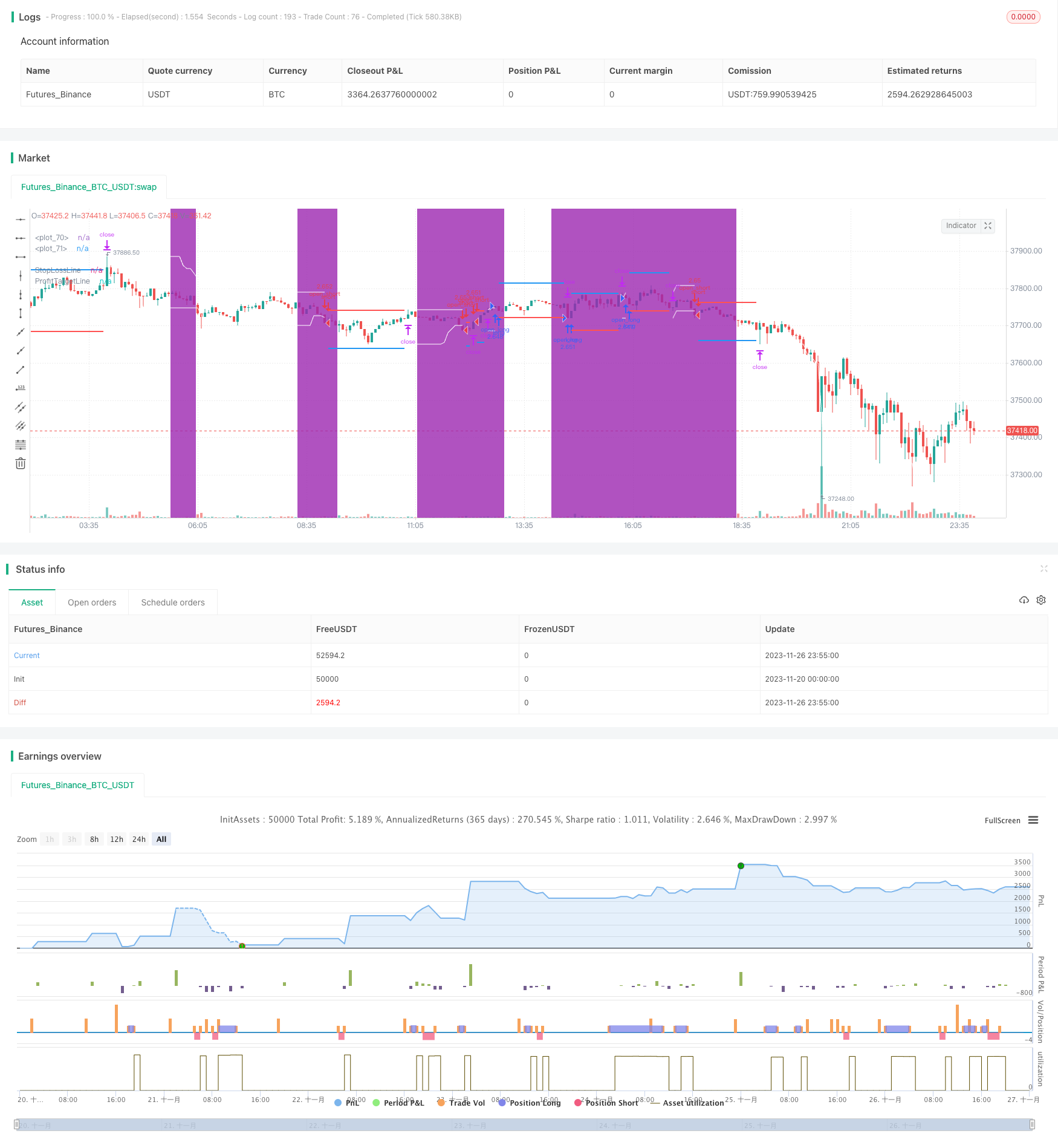
概述
ADX智能趋势跟踪策略利用平均趋向指数(ADX)来判断趋势的力量,在趋势较弱的时候进行趋势捕捉,在强势趋势中进行跟踪获利。该策略判断趋势力量的同时结合价格突破来产生交易信号,属于趋势跟踪策略的一种。
策略原理
该策略主要基于平均趋向指数(ADX)来判断目前的趋势力量。ADX通过计算一定周期内价格波动的 DIRECTIONAL INDICATOR 的平均值来表示趋势的力量。当ADX值低于设定阈值时,我们认为行情正在整理,这时进行方框范围判定,如果价格突破方框上下轨,产生交易信号。
具体来说,策略首先计算14周期的ADX值,低于18时认为趋势较弱。然后计算过去20根K线的最高价和最低价形成的方框范围。当价格突破该方框时,产生买入和卖出信号。止损距离为方框大小的50%,止盈距离为方框大小的100%。
该策略同时结合了趋势力量判断和突破信号,能够在趋势较弱而进入整理的情况下进行捕捉,避免在无序行情中频繁交易。而当出现强势趋势时,止盈范围较大,能够获得更多利润。
策略优势
- 结合趋势力量判断,能够避免在无序行情中频繁交易。
- 方框突破增加了一定的过滤,避免在震荡行情中被套。
- 在趋势行情中,能够获得更大的止盈空间。
- 可自定义ADX参数、方框参数、止损止盈系数等,适应不同品种。
策略风险
- ADX参数设置不当可能错过趋势或判断错误。
- 方框范围过大过小都可能影响效果。
- 止损止盈系数不当可能造成过小止损或止盈太早。
可以通过调整ADX参数、方框参数、止损止盈系数等来优化,使之更适合不同的品种和行情环境。同时严格的资金管理也很重要,控制单笔止损比例,避免单笔大损失。
策略优化方向
- ADX参数可以测试不同周期效果。
- 方框参数可以测试不同长度,判断最佳范围大小。
- 止损止盈系数可以微调,优化风险收益比。
- 可以测试仅做多、仅做空的单边交易效果。
- 可以加入其他指标进行组合,如增加量能指标等。
总结
ADX智能趋势跟踪策略总体来说是一种较为稳定的趋势策略。它同时结合了趋势力量判断和价格突破信号,在一定程度上避免了常见趋势跟踪策略中追高杀跌的问题。通过参数优化和严格的资金管理,可以使该策略稳定获利。
策略源码
/*backtest
start: 2023-11-20 00:00:00
end: 2023-11-27 00:00:00
period: 5m
basePeriod: 1m
exchanges: [{"eid":"Futures_Binance","currency":"BTC_USDT"}]
*/
//Developer: Andrew Palladino.
//Creator: Rob Booker.
//Date: 9/29/2017
//@version=5
//Date: 08/10/2022
//Updated to V5 from V1, default cash settings added and indicators made more easily visible by:
// @ Powerscooter
strategy("Rob Booker - ADX Breakout", shorttitle="ADX Breakout V5", overlay=true, default_qty_type = strategy.cash, default_qty_value = 100000, initial_capital = 100000)
adxSmoothPeriod = input(14, title="ADX Smoothing Period", group = "ADX Settings")
adxPeriod = input(14, title="ADX Period", group = "ADX Settings")
adxLowerLevel = input(18, title="ADX Lower Level", group = "ADX Settings")
boxLookBack = input(20, title="BreakoutBox Lookback Period", group = "BreakoutBox")
profitTargetMultiple = input(1.0, title="Profit Target Box Width Multiple", group = "Take Profit and Stop Loss")
stopLossMultiple = input(0.5, title="Stop Loss Box Width Multiple", group = "Take Profit and Stop Loss")
enableDirection = input(0, title="Both(0), Long(1), Short(-1)", group = "Trade Direction")
// When the ADX drops below threshold limit, then we consider the pair in consolidation.
// Set Box around highs and lows of the last 20 candles. with upper and lower boundaries.
// When price breaks outside of box, a trade is taken. (on close or on touch?)
// Stop is placed, default 50%, of the size of the box. So if box is 200 pips, stop is at 100 pips.
// Profit target is 100% of the size of the box. Default. User can set a profit target of 0.5, 1 full size, 2 or 3.
dirmov(len) =>
up = ta.change(high)
down = -ta.change(low)
truerange = ta.rma(ta.tr, len)
plus = fixnan(100 * ta.rma(up > down and up > 0 ? up : 0, len) / truerange)
minus = fixnan(100 * ta.rma(down > up and down > 0 ? down : 0, len) / truerange)
[plus, minus]
adx(dilen, adxlen) =>
[plus, minus] = dirmov(dilen)
sum = plus + minus
adx = 100 * ta.rma(math.abs(plus - minus) / (sum == 0 ? 1 : sum), adxlen)
adxHigh(dilen, adxlen) =>
[plus, minus] = dirmov(dilen)
plus
adxLow(dilen, adxlen) =>
[plus, minus] = dirmov(dilen)
minus
sig = adx(adxSmoothPeriod, adxPeriod)
//sigHigh = adxHigh(dilen, adxlen)
//sigLow = adxLow(dilen, adxlen)
isADXLow = sig < adxLowerLevel
//boxUpperLevel = ta.highest(high, boxLookBack)[1]
//boxLowerLevel = ta.lowest(low, boxLookBack)[1]
var float boxUpperLevelCarry = 0
var float boxLowerLevelCarry = 0
boxUpperLevel = strategy.position_size == 0 ? ta.highest(high, boxLookBack)[1] : boxUpperLevelCarry
boxUpperLevelCarry := boxUpperLevel
boxLowerLevel = strategy.position_size == 0 ? ta.lowest(low, boxLookBack)[1] : boxLowerLevelCarry
boxLowerLevelCarry := boxLowerLevel
boxWidth = boxUpperLevel - boxLowerLevel
profitTarget = strategy.position_size > 0 ? strategy.position_avg_price + profitTargetMultiple*boxWidth : strategy.position_size < 0 ? strategy.position_avg_price - profitTargetMultiple*boxWidth : na
stopLoss = strategy.position_size > 0 ? strategy.position_avg_price - stopLossMultiple*boxWidth : strategy.position_size < 0 ? strategy.position_avg_price + stopLossMultiple*boxWidth : na
plot(strategy.position_size == 0 ? boxUpperLevel : na, color=color.white, style = plot.style_linebr)
plot(strategy.position_size == 0 ? boxLowerLevel : na, color=color.white, style = plot.style_linebr)
bgcolor(isADXLow ? color.purple : na, transp=72, title = "ADX limit")
plot(stopLoss, color=color.red, linewidth=2, style = plot.style_linebr, title="StopLossLine")
plot(profitTarget, color=color.blue, linewidth=2, style = plot.style_linebr, title="ProfitTargetLine")
isBuyValid = strategy.position_size == 0 and ta.cross(close, boxUpperLevel) and isADXLow
//Long Entry Condition
strategy.exit("close_long", from_entry="open_long", limit = profitTarget, stop = stopLoss)
if isBuyValid and strategy.opentrades == 0 and (enableDirection == -1 or enableDirection == 0)
strategy.entry("open_long", strategy.long)
isSellValid = strategy.position_size == 0 and ta.cross(close, boxLowerLevel) and isADXLow
//Short Entry condition
strategy.exit(id="close_short", from_entry="open_short", limit = profitTarget, stop = stopLoss)
if isSellValid and strategy.opentrades == 0 and (enableDirection == 1 or enableDirection == 0)
strategy.entry("open_short", strategy.short)